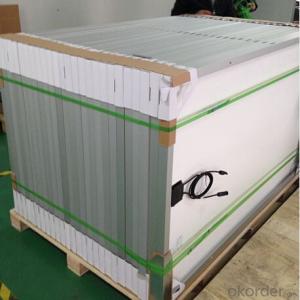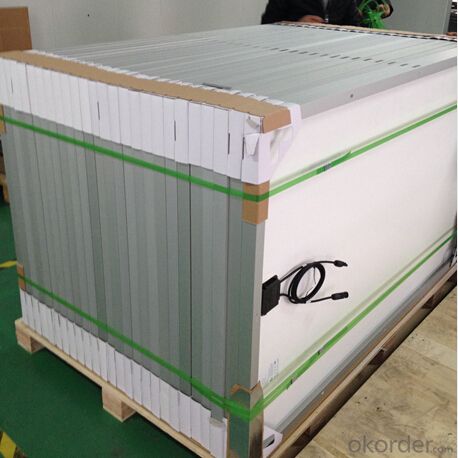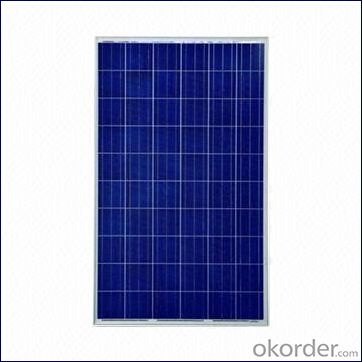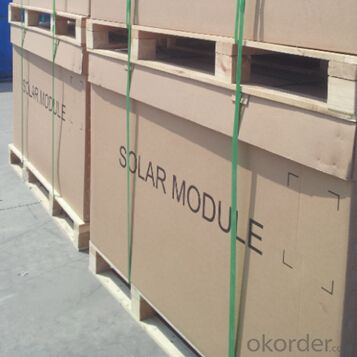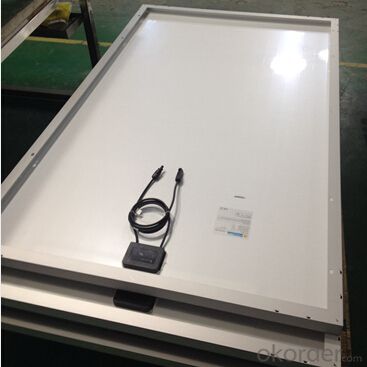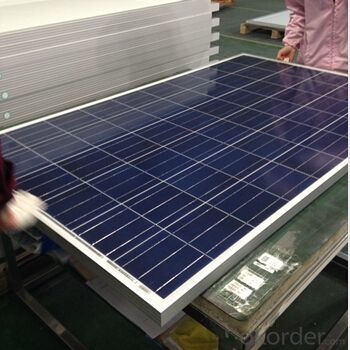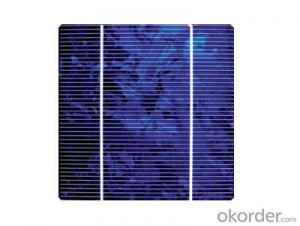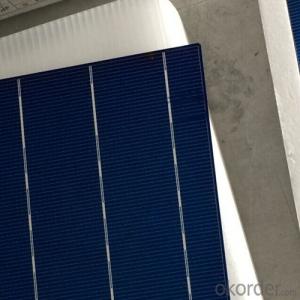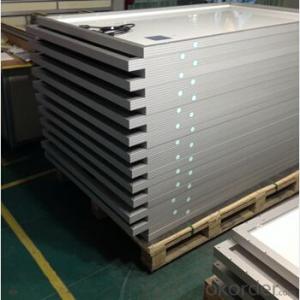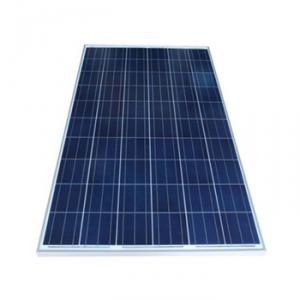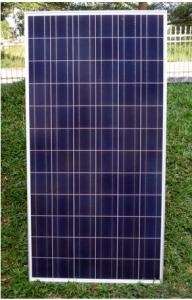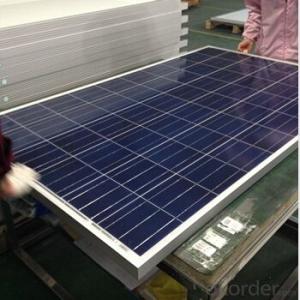Inorganic Solar Cells - Polycrystalline Solar Panels for 250W - 156*156 Poly Cell
- Loading Port:
- Shanghai
- Payment Terms:
- TT OR LC
- Min Order Qty:
- 25 pc
- Supply Capability:
- 100000 pc/month
OKorder Service Pledge
OKorder Financial Service
You Might Also Like
Specifications:
Structure of Polycrystalline Solar Panel
Polycrystalline Solar Panel for : High efficiency crystalline solar cell.
Even if under the weak light, the solar module can produce maximum power output.
II Tempered glass (toughened glass): Anti-reflecting coating and high transmission rate glass increase the power output and mechanical strength of solar module.
III EVA and TPT: Using high quality EVA and TPT to prevent destroying and water.
IV AI frame: Without screw, rner connection. 6 holes on the frame can be installed easily.
V Junction box: Multi function junction box with water proof.
VI Long lifetime: ≥25 years; Less power decrease.
VII Good performance of preventing from atrocious weather such as wind and hails.
VIII Resisting moisture and etching effectively, not effected by geology.
IX The certificate issued by international authority: UL, TUV, IEC, CE.
Standard Test Conditions of Polycrystalline Silicon Solar Panel:
The opto-electrical specifications shown below are stabilized values being measured at Standard Test Conditions, Irradiance: 1000W/m2, Spectrum: AM1.5 at 25°C, The info below is subject to manufacturing tolerances.
Where appropriate minutes of measurement are available and are used for the dimensioning of the installation.
Advantages of Monocrystalline Silicon Solar Panel
• CNBM Solar performance guarantees for 25 years
• 12 years guarantee for workmanship
• Timeliness of delivery
• Quality Products certified (TÜV, UL, CE, ISO)
Characteristics:
I.Solar Cell : High efficiency crystalline solar cell. Even if under the weak light, the solar module can produce maximum power output.
II.Tempered glass (toughened glass): Anti-reflecting coating and high transmission rate glass increase the power output and mechanical strength of solar module.
III.EVA and TPT: Using high quality EVA and TPT to prevent destroying and water.
IV.AI frame: Without screw, corner connection. 6 holes on the frame can be installed easily.
V.Junction box: Multi function junction box with water proof.
VI.Long lifetime: ≥25 years; Less power decrease.
VII.Good performance of preventing from atrocious weather such as wind and hails.
VIII.Resisting moisture and etching effectively, not effected by geology.
IX.The certificate issued by international authority: UL, TUV, IEC, VDE, CE.
Quality and Safety
1. Rigorous quality control meets the highest international standards.
2. High-transmissivity low-iron tempered glass, strong aluminium frame.
3. Using UV-resistant silicon.
4. IS09001/14001/CE/TUV/UL
Technical date :
ITEM NO.: | Poly 156*156 cell ,60pcs . Power range from 230Wp-260Wp | ||||||
Maximum Power(W) | 230 | 235 | 240 | 245 | 250 | 255 | 260 |
Optimum Power Voltage(Vmp) | 29.4 | 29.5 | 29.7 | 30.1 | 30.3 | 30.5 | 30.7 |
Optimum Operatige Current(Imp) | 7.83 | 7.97 | 8.08 | 8.14 | 8.25 | 8.37 | 8.48 |
Open Circuit Voltage(Voc) | 36.7 | 36.8 | 36.9 | 37.1 | 37.3 | 37.5 | 37.7 |
Short Circuit Current(Isc) | 8.52 | 8.59 | 8.62 | 8.65 | 8.69 | 8.73 | 8.78 |
Solar Cell: | 156*156 Poly | ||||||
Number of Cell(pcs) | 6*10 | ||||||
Name of Solar Cells | Polycrystalline Cell | ||||||
Size of Module(mm) | 1650*992*40/45/50 | ||||||
Cable & Connector Type | Pass the TUV Certificate | ||||||
Frame(Material Corners,etc.) | Aluminium-alloy | ||||||
Back sheet | TPT | ||||||
Weight Per Piece(KG) | 19.5KG | ||||||
FF (%) | 70-76% | ||||||
Junction Box Type | Pass the TUV Certificate | ||||||
Tolerance Wattage(e.g.+/-5%) | ±3%, or 0-3% | ||||||
Front Glass Thickness(mm) | 3.2 | ||||||
Temperature Coefficients of Isc(%) | +0.04 | ||||||
Temperature Coefficients of Voc(%) | -0.38 | ||||||
Temperature Coefficients of Pm(%) | -0.47 | ||||||
Temperature Coefficients of Im(%) | +0.04 | ||||||
Temperature Coefficients of Vm(%) | -0.38 | ||||||
Temperature Range | -40°C to +85°C | ||||||
Surface Maximum Load Capacity | 5400Pa | ||||||
Allowable Hail Load | 23m/s ,7.53g | ||||||
Bypass Diode Rating(A) | 12 | ||||||
Warranty | 90% of 10 years, 80% of 25 years. | ||||||
Standard Test Conditions | AM1.5 1000W/ 25 +/-2°C | ||||||
Packing | carton or pallet | ||||||
1*20' | 14 Pallets / 316pcs | ||||||
1*40'STD | 25 Pallets / 700pcs | ||||||
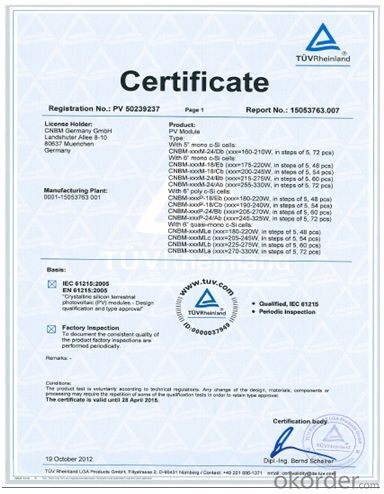

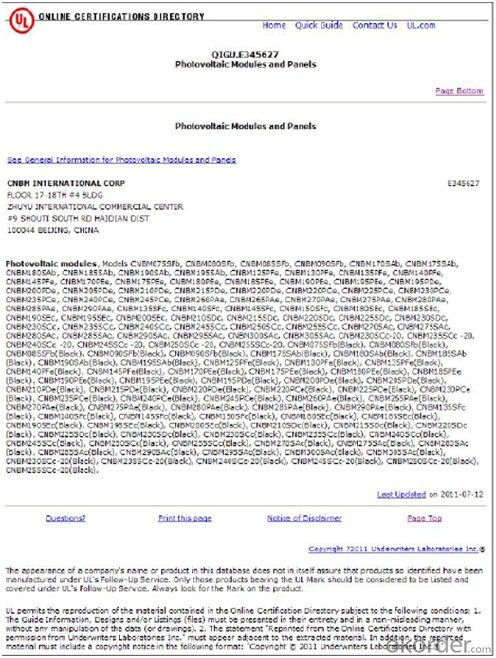

FAQ
We have organized several common questions for our clients,may help you sincerely:
①What price for each watt?
It depends on the quantity, delivery date and payment terms,
②What is your size for each module? Can you tell me the Parameter of your module?
We have different series of panels in different output, both c-Si and a-Si. Please take the specification sheet for your reference.
③Can you provide the peripheral products of the solar panels, such as the battery, controller, and inverter? If so, can you tell me how do they match each other?
Yes, we can, we have two companies for solar region, one is CNBM International, the other is CNBM engineering Co.
We can provide you not only the solar module but also the off grid solar system, we can also provide you service with on grid plant.
④What is your warranty system?
Our product performance guarantees for 25 years
• 12 years guarantee for workmanship
• Timeliness of delivery
• Quality Products certified (TÜV, UL, CE, ISO)
⑤How do you pack your products?
We have rich experience on how to pack the panels to make sure the safety on shipment when it arrives at the destination.
⑥ Can you do OEM for us?
Yes, we can.
- Q: What are the advantages and disadvantages of solar panels and diodes?
- If it is in series, then the rectifier effect, the use of one-way diode conductivity, the AC voltage to DC voltage, to ensure that the output voltage polarity is positive
- Q: What is the impact of solar cells on reducing noise pollution from power generation?
- Solar cells have a minimal impact on reducing noise pollution from power generation since they operate silently, unlike traditional power plants that emit noise during operation.
- Q: Can solar cells be used in residential homes?
- Yes, solar cells can be used in residential homes. They are a sustainable and renewable energy source that can generate electricity by converting sunlight into usable energy. Installing solar panels on residential rooftops allows homeowners to generate their own clean energy and reduce their reliance on traditional fossil fuel-based electricity.
- Q: Can solar cells be used in medical devices?
- Yes, solar cells can be used in medical devices. Solar cells can provide a renewable and sustainable source of energy for various medical devices, such as remote monitoring systems, wearable devices, and even implantable devices. They can help eliminate the need for frequent battery replacements and provide continuous power supply, making them particularly useful in remote or resource-limited areas.
- Q: Can solar cells be used for powering amusement parks?
- Yes, solar cells can be used for powering amusement parks. Solar energy can be harnessed through solar panels, which can generate electricity to power various rides, lighting systems, and other infrastructure within the park. It is a sustainable and environmentally friendly alternative to traditional energy sources, reducing the carbon footprint and operating costs of the amusement park.
- Q: Can solar cells be used to power data centers?
- Yes, solar cells can be used to power data centers. Solar panels can generate electricity from sunlight, which can be used to power the energy needs of data centers. However, the feasibility and effectiveness of using solar power for data centers depend on various factors such as the size of the data center, the availability of sunlight, energy storage solutions, and the overall energy consumption of the facility.
- Q: Can solar cells be used in powering e-bikes?
- Yes, solar cells can be used to power e-bikes. Solar panels can be mounted on the bike's frame or incorporated into accessories like panniers or baskets. These panels convert sunlight into electricity, which charges the bike's battery, providing a renewable and sustainable source of power.
- Q: Are solar cells affected by shade or partial shading?
- Yes, solar cells are significantly affected by shade or partial shading. Even a small amount of shade on a solar cell or panel can have a significant impact on its energy production. Shadows cast on solar cells can reduce their efficiency and overall power output, as shading prevents sunlight from reaching the shaded areas, thereby reducing the amount of energy that can be converted into electricity. Therefore, it is essential to ensure that solar panels are installed in areas where they can receive maximum sunlight exposure throughout the day to maximize their performance.
- Q: Can solar cells be used in museums?
- Yes, solar cells can be used in museums. They can provide renewable energy to power museum exhibits, lighting, and other electrical systems, reducing the reliance on traditional energy sources and minimizing the environmental impact. Additionally, solar cells can be integrated into the design of the museum building itself, enhancing its sustainability and showcasing a commitment to renewable energy.
- Q: How do solar cells handle lightning strikes or electrical surges?
- Solar cells do not have built-in protection against lightning strikes or electrical surges. However, they are usually connected to a surge protection device or a lightning arrestor to divert the excessive current away from the solar panel system. This helps to minimize the risk of damage to the solar cells and associated equipment.
Send your message to us
Inorganic Solar Cells - Polycrystalline Solar Panels for 250W - 156*156 Poly Cell
- Loading Port:
- Shanghai
- Payment Terms:
- TT OR LC
- Min Order Qty:
- 25 pc
- Supply Capability:
- 100000 pc/month
OKorder Service Pledge
OKorder Financial Service
Similar products
Hot products
Hot Searches
Related keywords
